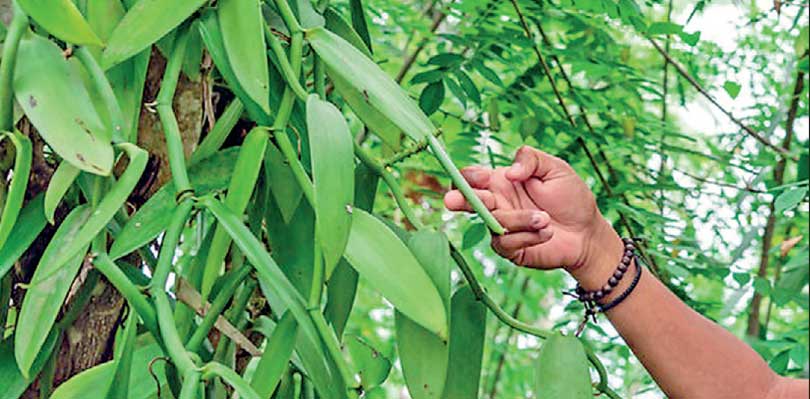Wednesday Apr 16, 2025
Wednesday Apr 16, 2025
Thursday, 7 March 2024 00:19 - - {{hitsCtrl.values.hits}}

For centuries, Sri Lanka has been known for its exquisite Ceylon tea. However, a new contender is transforming the island’s agricultural landscape: vanilla. The delicate orchid pod that graces kitchens and desserts worldwide, is emerging as a promising alternative crop, founding a surprisingly fertile home in Sri Lanka’s tropical climate.
From Ceylon spices to Sri Lankan vanilla: Diversifying landscape
 While the initial introduction of the plant in the 19th century by the British with the hope to replicate the success of Madagascar faced challenges, modern advancements in cultivation techniques with the introduction of hand-pollination techniques and the establishment of specialised vanilla nurseries, and a renewed focus on diversification with farmers, particularly those in the central highlands and the wet zone, have led to a resurgence of vanilla production in the country. Farmers are attracted to the chance to diversify their agricultural portfolio as a viable alternative to traditional crops predominantly being an intercrop to other spices such as pepper and cloves. This enables farmers to get extra income to help release their financial burdens. Comparatively, vanilla cultivation involves mostly women supporting women empowerment.
While the initial introduction of the plant in the 19th century by the British with the hope to replicate the success of Madagascar faced challenges, modern advancements in cultivation techniques with the introduction of hand-pollination techniques and the establishment of specialised vanilla nurseries, and a renewed focus on diversification with farmers, particularly those in the central highlands and the wet zone, have led to a resurgence of vanilla production in the country. Farmers are attracted to the chance to diversify their agricultural portfolio as a viable alternative to traditional crops predominantly being an intercrop to other spices such as pepper and cloves. This enables farmers to get extra income to help release their financial burdens. Comparatively, vanilla cultivation involves mostly women supporting women empowerment.
Unique and distinctive flavour
Sri Lankan vanilla boasts a distinct character, setting it apart from its more prominent counterparts like Madagascan or Tahitian vanilla. Sri Lankan vanilla offers a subtle and delicate flavour profile with hints of caramel and floral notes, slowly gaining appreciation amongst chefs and connoisseurs seeking innovative ways to elevate their creations.
A spectrum of opportunities
The success of Sri Lankan vanilla cultivation extends beyond the bean itself. It has spurred the creation of new vanilla-based products like natural extracts, pastes, and even vanilla-infused beverages. Additionally, the fragrance and moisturising properties of vanilla have led to its use in high-end cosmetics, such as soaps, moisturisers, and perfumes. This ever-growing global demand for natural vanilla, with an annual global market growth rate of over 5.5%, strengthens Sri Lanka’s position as a player in the global vanilla market opening doors for further economic development.
Sustainability at the forefront
Moreover, Sri Lankan vanilla farmers are increasingly embracing sustainable agricultural practices with emphasis being placed on organic cultivation methods, eliminating the use of chemicals and preserving the delicate ecosystem for future generations. This commitment to sustainability resonates with conscious consumers worldwide, further enhancing the appeal of Sri Lankan vanilla on the global stage.
Promising growth prospects
Sri Lankan vanilla, once a hidden gem, is poised to take its place alongside its established neighbour, Ceylon tea, offering the world a new and exciting taste. With its unique flavour profile, commitment to sustainability, and growing production capacity, Sri Lankan vanilla is well-positioned to become a significant player in the global vanilla market. This new chapter in Sri Lanka’s agricultural story promises to be as rich and flavourful as the island’s history itself.
(The writer has over three years of experience in plant based agri-exports with a special interest in the development of Sri Lankan vanilla.)